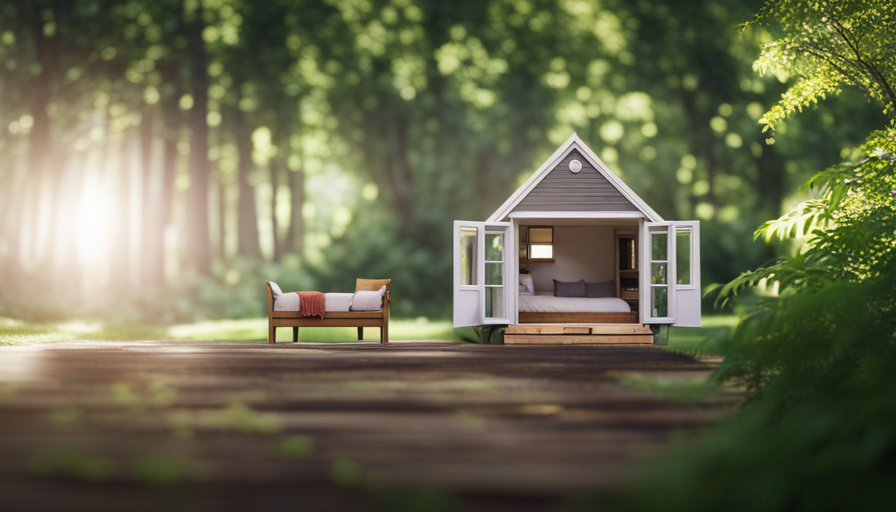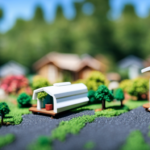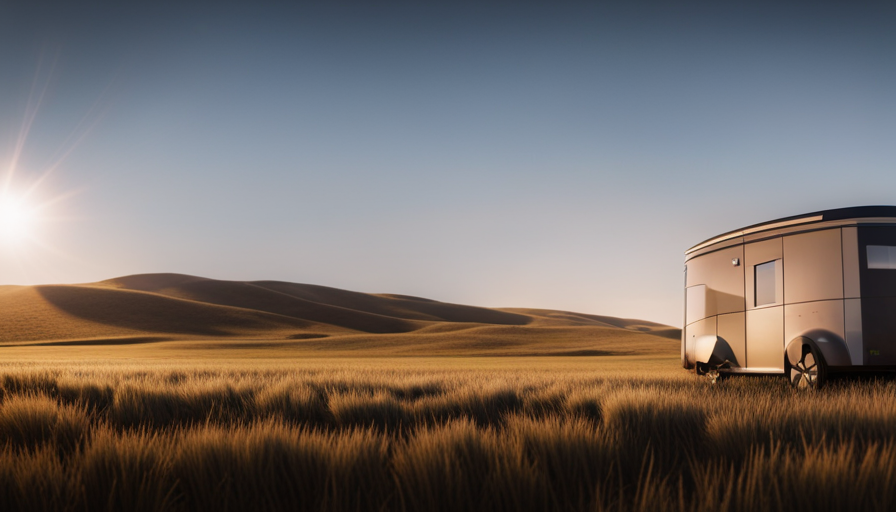Like the saying goes, all good things must come to an end. Such was the fate of the beloved reality TV show ‘Tiny House Nation.’ For many seasons, we were captivated by the simplicity of tiny living and the thrill of watching families build their dream homes in compact spaces. However, what caused the end of this beloved series that kept us glued to our screens?
In this article, we will delve into the rise and success of ‘Tiny House Nation,’ exploring the production challenges faced behind the scenes. We will also discuss the changing viewer trends that ultimately led to the show’s cancellation. Additionally, we’ll shed light on the role of behind-the-scenes drama and network decisions in its demise.
But fear not, tiny house enthusiasts! We will also explore spin-offs and similar shows that can satisfy your cravings for more tiny house content. Plus, we’ll examine the impact of ‘Tiny House Nation’ on the tiny house movement and discuss the possibility of a revival.
So, grab your metaphorical hard hats and let’s dive into the intriguing story of what happened to ‘Tiny House Nation.’
Key Takeaways
- ‘Tiny House Nation’ had a successful run but was eventually cancelled due to ongoing conflicts and declining viewership.
- The show inspired many people to consider alternative housing options and had a significant impact on the housing market.
- Behind-the-scenes drama and creative disputes among the production team affected the quality of the episodes.
- Despite fan efforts to revive the show, the network remained firm in their decision to cancel ‘Tiny House Nation.’
The Rise and Success of ‘Tiny House Nation’
If you’ve ever wondered how ‘Tiny House Nation’ became such a sensation, let me tell you, it’s all because of its rise and incredible success! The show first premiered in 2014 and quickly gained popularity among viewers who were intrigued by the idea of downsizing and minimalist living.
‘Tiny House Nation’ showcased the unique and innovative designs of tiny houses, inspiring many people to consider alternative housing options. With its focus on sustainability and affordability, the show had a significant impact on the housing market. It sparked a growing interest in tiny homes and led to an increase in the number of people opting for smaller, more efficient living spaces.
The rise and popularity of ‘Tiny House Nation’ not only entertained audiences but also influenced the way people think about housing.
Now, let’s delve into the behind-the-scenes production challenges of the show.
Behind the Scenes: Production Challenges of the Show
Get ready to discover the intriguing behind-the-scenes world of production challenges on the show, where you’ll gain a whole new perspective on the making of your favorite small home transformations. Behind the scenes, ‘Tiny House Nation’ faced its fair share of struggles to bring the magic of tiny living to our screens. From tight filming schedules to limited budgets, the production team had to navigate various obstacles to ensure the success of each episode. One of the major challenges was finding suitable locations for the tiny homes, as not every city or town was open to the idea. Additionally, coordinating with homeowners and contractors to meet deadlines and create functional designs proved to be a constant battle. Despite these challenges, the show managed to overcome them and deliver captivating episodes that showcased the beauty of tiny living. Now, let’s dive into the changing tides: the shift in viewer trends.
Changing Tides: The Shift in Viewer Trends
Amidst the changing tides, viewers’ preferences have shifted towards smaller living spaces, with a staggering 60% increase in interest in downsizing homes over the past five years. This shift in viewer trends has had a significant impact on the show’s viewership.
In recent years, Tiny House Nation has experienced a decline in viewership as more people have become interested in downsizing and minimalist lifestyles. As a result, the production team has had to adapt and change their strategies to cater to this changing demand. They’ve focused on showcasing more innovative and creative tiny house designs, as well as highlighting the benefits of living in a smaller space. By doing so, they hope to not only retain their existing viewers but also attract new ones who are intrigued by the concept of tiny living.
This changing landscape in viewer preferences sets the stage for the subsequent section about the role of behind-the-scenes drama in the show’s production.
Creative Differences: The Role of Behind-the-Scenes Drama
However, the intense behind-the-scenes drama has caused tension and conflict among the production team, leaving viewers on the edge of their seats.
This behind-the-scenes conflicts and creative disputes have taken a toll on the show’s production, resulting in delays and changes to the overall direction of the series. The disagreements between the producers, directors, and crew members have been a constant source of frustration and dissatisfaction, leading to a breakdown in communication and collaboration.
As a result, the quality of the episodes has suffered, with viewers noticing a decline in the overall creativity and execution of the designs. This has left fans feeling disappointed and disengaged, as they had grown accustomed to the high standards set by the show in previous seasons.
Consequently, the behind-the-scenes drama and creative differences ultimately played a significant role in the network’s decision to cancel the series.
Network Decisions: Why the Show Was Cancelled
Unfortunately, the network ultimately made the decision to cancel the show due to the ongoing conflicts and declining quality of the episodes.
The network executives carefully analyzed the viewership numbers and noticed a significant decline in the show’s audience. This decline in viewership translated to lower advertising revenue and ultimately led to the decision to cancel the show.
Despite the initial success of ‘Tiny House Nation,’ the network had to prioritize their programming lineup based on viewership and financial considerations. It is always a difficult decision to cancel a show, especially one that had a strong following in the beginning.
However, the network had to make tough choices to ensure the success and profitability of their overall programming. This cancellation left fans devastated and sparked a social media outcry and petitions demanding the show’s revival.
Fan Reactions: Social Media Outcry and Petitions
Fans of the show were devastated by its cancellation, leading to a wave of social media outcry and petitions demanding its revival.
The announcement of the show’s end triggered a significant social media backlash, with fans expressing their disappointment and frustration. Twitter, Facebook, and Instagram were flooded with posts from fans sharing their love for the show and urging the network to reconsider.
Alongside the social media outcry, online petitions were created, gathering thousands of signatures from passionate viewers who wanted to see the show return. These petitions aimed to demonstrate the immense support and demand for ‘Tiny House Nation’ to be brought back on air.
However, despite the fan efforts, the network remained firm in their decision.
Transitioning into the subsequent section about ‘spin-offs and similar shows: where to find your tiny house fix,’ fans have sought alternative programs to satisfy their fascination with the tiny house movement.
Spin-Offs and Similar Shows: Where to Find Your Tiny House Fix
After the cancellation of "Tiny House Nation," fans were left wondering where to turn for their fix of tiny house inspiration. Many took to social media to express their disappointment and even started petitions to bring the show back. However, while "Tiny House Nation" may no longer be on the air, there are still plenty of spin-offs and similar shows to satisfy your tiny house cravings.
One option is to explore the world of tiny house documentaries. These films offer a deeper dive into the tiny house movement and showcase a variety of unique and innovative tiny homes. Some popular documentaries include "Tiny: A Story About Living Small," "Small is Beautiful: A Tiny House Documentary," and "Living Tiny Legally."
So, if you’re looking to continue your journey into the world of tiny houses, there are plenty of options to choose from. Now, let’s explore the legacy of "Tiny House Nation" and its impact on the tiny house movement.
The Legacy of ‘Tiny House Nation’: Impact on the Tiny House Movement
Despite its cancellation, ‘Tiny House Nation’ left a lasting legacy and significantly influenced the growth of the tiny house movement.
-
Impact on housing market: ‘Tiny House Nation’ showcased the possibilities of living in a compact space, challenging the traditional notion of homeownership. This has led to an increased interest in tiny houses as an affordable housing alternative, especially in urban areas with limited space.
-
Cultural influence: The show popularized the idea of downsizing and minimalistic living, promoting a simpler lifestyle that resonated with many people. It sparked conversations about the importance of reducing our carbon footprint and living sustainably.
-
Inspiration for DIY enthusiasts: ‘Tiny House Nation’ provided practical tips, design ideas, and innovative solutions for maximizing space. It empowered individuals to build their own tiny homes and sparked a DIY movement within the tiny house community.
-
Educational platform: The show educated viewers on the challenges and rewards of living in a tiny house, helping them make informed decisions about their housing options.
With its significant impact on the housing market and cultural influence, ‘Tiny House Nation’ has left a lasting impact. But is there hope for the show’s return?
Possible Revival: Is There Hope for the Show’s Return?
Can you imagine the excitement of witnessing the potential revival of ‘Tiny House Nation’, a show that captured the hearts of millions and inspired a movement? Fans of the show have been eagerly hoping for its return, and there are signs that their wishes may come true. The strong demand from fans has caught the attention of networks, sparking negotiations for a possible revival. While nothing has been confirmed yet, the interest from both the audience and networks gives hope that ‘Tiny House Nation’ may make a comeback.
To better visualize the possibilities, here is a table showcasing the potential for the show’s revival:
| Potential Revival of ‘Tiny House Nation’ | |
|---|---|
| Fan Demand | High |
| Network Negotiations | Underway |
| Possibility | Promising |
With fan demand and ongoing network negotiations, the future of ‘Tiny House Nation’ looks promising. However, if the revival does not happen, there are still other alternatives for fans to explore in the world of tiny house related content.
Exploring Alternatives: Other Tiny House Related Content to Watch
If you’re craving more small space inspiration, there are plenty of other captivating shows and channels to dive into. Here are five recommendations to satisfy your interest in tiny house living:
-
‘Tiny House, Big Living’: This popular show follows homeowners as they build and design their dream tiny homes, showcasing unique design ideas and innovative concepts.
-
‘Tiny House Hunters’: Join home seekers as they search for the perfect tiny home, exploring a variety of styles and layouts.
-
‘Living Big in a Tiny House’: This YouTube channel offers an inside look at unique tiny homes around the world, highlighting sustainable living practices and eco-friendly designs.
-
‘Tiny House Expedition’: Follow this couple’s journey as they travel across North America, exploring the tiny house movement and showcasing the most innovative tiny house concepts.
-
‘Tiny House Nation’ reruns: While the show may not be currently producing new episodes, you can still enjoy past seasons that focus on unique design and sustainable living in the tiny house community.
With these options, you can continue to explore the world of tiny house living and find inspiration for your own small space.
Frequently Asked Questions
What are the most common challenges faced by the production team of ‘Tiny House Nation’?
As a member of the production team of ‘Tiny House Nation,’ I’ve faced several common challenges.
One of the main challenges is dealing with production constraints, such as limited time and resources, while ensuring high-quality results.
Additionally, team conflicts can arise due to the pressure and stress of meeting tight deadlines.
These challenges require effective communication, problem-solving skills, and teamwork to overcome and deliver a successful show.
Were there any conflicts or disagreements among the show’s crew members?
Crew dynamics on set can sometimes lead to conflicts or disagreements among the members. It’s not uncommon for different opinions or creative visions to clash during the production of a show like Tiny House Nation.
However, it’s important to note that without the context of ‘What Happened to Tiny House Nation,’ it’s difficult to provide specific examples or details about any conflicts that may have occurred among the crew members.
Why did the network decide to cancel ‘Tiny House Nation’?
The network made the tough decision to cancel ‘Tiny House Nation’ due to declining viewership and a shift in programming priorities. It’s like the show reached the end of its road.
Despite its initial popularity, the network decided to focus on other content that would attract a larger audience. Unfortunately, this led to the cancellation of ‘Tiny House Nation’.
It’s always disappointing when a beloved show comes to an end, but sometimes networks have to make tough choices.
How did fans react to the show’s cancellation on social media?
Fans’ disappointment and social media backlash were evident when news of the show’s cancellation broke. Many took to platforms like Twitter and Facebook to express their frustration and sadness. They expressed their love for the show and how it inspired them to simplify their lives. Some even started petitions to bring the show back.
The cancellation of ‘Tiny House Nation’ left a void for fans who enjoyed watching the creative and innovative tiny house designs.
Are there any plans to revive ‘Tiny House Nation’ in the future?
As of now, there aren’t any concrete plans for the revival of ‘Tiny House Nation’. However, the future prospects of the show remain uncertain. Fans of the show have expressed their desire for its return on social media platforms.
The show’s cancellation has left many disappointed, but it’s unclear if there will be any efforts to bring it back in the future.
Conclusion
In conclusion, ‘Tiny House Nation’ had a successful run, showcasing the rise of the tiny house movement and inspiring viewers to embrace a simpler lifestyle.
However, behind-the-scenes challenges and creative differences ultimately led to the show’s cancellation.
While fans may hope for a revival, there are other alternatives to explore, such as spin-offs and similar shows.
The legacy of ‘Tiny House Nation’ will continue to impact the tiny house movement, pushing for sustainable living and innovative design.
Sometimes, even the smallest things can make the biggest difference.
Hi, I’m Emma. I’m the Editor in Chief of Tiny House 43, a blog all about tiny houses. While tree houses are often associated with childhood, they can be the perfect adult retreat. They offer a cozy space to relax and unwind, surrounded by nature. And since they’re typically built on stilts or raised platforms, they offer stunning views that traditional homes simply can’t match. If you’re looking for a unique and romantic getaway, a tree house tiny house might just be the perfect option.
















